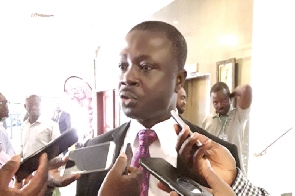 Executive Secretary of GHASALC, Tweneboah Kodua Boakye
Executive Secretary of GHASALC, Tweneboah Kodua Boakye
Savings and loans companies (S&Ls) in the country are seeking additional sources of funding, amid a plethora of factors – including protracted operationalisation of the GH¢15billion financial sector stability fund.
This position was made known during the 13th annual general meetings (AGM) of the industry’s umbrella body – the Ghana Association of Savings and Loans Companies (GHALSAC), which had as its theme ‘The economic outlook of Ghana– opportunities and challenges for the savings and loans sector’.
Already, S&Ls – operating at the low end of the market – are experiencing mounting pressure as the Monetary Policy Rate stands at 29.5 percent, with market projections suggesting that it will not be reduced due to inflation rising to 42.50 percent in June 2023.
Additionally, the 91-day Treasury bill rate is at 23 percent and the Ghana Reference Rate for July is recorded at 27.98 percent. Furthermore, the suspension of dividend payments has made appealing to shareholders an uphill task.
The Head of Banking Supervision at the Bank of Ghana (BoG), Osei Gyasi – representing Governor Ernest Addison, expressed concerns in regard to increasing non-performing loans (NPLs) and rising funding costs in the sub-sector.
Mr. Gyasi pointed out the potential threats these issues pose to safety and stability of the sector, highlighting the need to diversify funding sources to enhance profitability and foster customer confidence.
“The BoG has observed increases in NPLs and funding costs, which may sooner rather than later threaten the sub-sector’s safety and stability,” he said.
However, the regulator identified the significant potential in the semi-formal segment for S&Ls to contribute in financial inclusion and resource mobilisation. He stated that there is a sizeable underbanked population in the country for S&Ls to offer targetted financial products.
“There are large portions of the population which remain unbanked, and S&Ls can take advantage of this by providing targetted financial products such as loans to farmers and agricultural businesses,” he noted.
He further stressed the need for S&Ls to develop innovative and accessible financial solutions that are simple, easy to use and affordable.
By leveraging technology, Gyasi suggested, the barriers to entry could be reduced, transactions streamlined and access to services improved. He also encouraged S&Ls to explore partnerships with banks and fintech companies to broaden their scope of operations.
Review
The Executive Secretary of GHASALC, Tweneboah Kodua Boakye, explained that players are not out of the woods yet – owing to the difficulties faced in 2022.
He added that factors such as customer uncertainties, panic withdrawals, loan defaults, new transaction levies, and government delays in disbursing funds to institutions granting government worker loans came to bear on the sub-sector’s fortunes.
“Times were tough for some of our members as we went through the year – with some dealing with solvency and liquidity issues. Due to varied reasons, including the Domestic Debt Exchange Programme (DDEP), customer uncertainties resulted in some panic withdrawals and loan defaults…bringing more pressure on the sector,” he said.
One of the major factors affecting the sector was introduction of the E-levy on certain transactions and the mandatory use of only the Ghana Card for identification in all banking transactions.
Consequently, GHASALC members had to invest considerable time and unbudgeted resources to ensure compliance with these directives – which added to their operational challenges, he said.
Moreover, institutions granting government worker loans – commonly known as Controller Loans – were hit hard by government’s delayed disbursement of funds. In some cases these institutions went without receiving funds for as long as four months, resulting in customer agitations and liquidity constraints, Mr. Boakye explained.
The Executive Secretary of GHASALC also expressed concern over the collective effect of these challenges on the savings and loans sector, calling for support and collaboration from relevant stakeholders.
“We urge government, regulatory bodies and other industry players to work together on finding sustainable solutions that will stabilise the sector and restore confidence among investors and customers,” he noted.
The association comprises a group of 25 members which collectively oversee more than seven million customer accounts. By the end of 2022, their assets had reached an estimated GH¢5.7billion; 33 percent of the specialised deposit-taking and non-bank financial institution (SDI-NBFI) market.
Additionally, these members operate from a network of 570 business outlets spread across all 16 regions of the country, employing over 7,000 staff.
In terms of financial performance, GHASALC demonstrated improvement compared to the previous year; achieving total revenue of GH¢607,000 as against the GH¢481,000 earned in 2021.
This resulted in a surplus of GH¢39,800 – a significant improvement from the previous year’s loss of GH¢59,000.